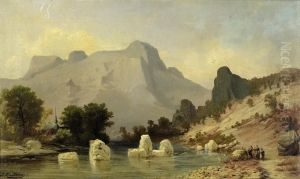Johann Sommer Paintings
Johann Sommer, also known as Johannes Sommerus, was a notable figure in the 16th-century intellectual landscape, primarily recognized for his contributions as a humanist, educator, and a writer, rather than as an artist in the conventional sense. Born in 1542, Sommer's life was deeply entrenched in the cultural and scholarly currents of the Renaissance, a period marked by a fervent revival of learning based on classical sources. While specific details of his early life are scarce, it is known that Sommer pursued an education that was rich in the humanities, reflecting the era's valorization of classical knowledge.
Sommer's career is distinguished by his engagement with the educational reforms of his time. He was part of a broader movement that sought to refine the methods and content of education, advocating for a curriculum that balanced traditional scholasticism with the emerging humanist emphasis on classical texts and languages. Sommer worked primarily in Central Europe, where he contributed to the intellectual and cultural life through his teaching and his writings. His works often focused on moral philosophy and pedagogy, aiming to prepare students not only for scholarly pursuits but also for virtuous lives.
Despite the brevity of his life, Sommer's impact was notable among his contemporaries. He was deeply involved in the Protestant Reformation, aligning himself with its emphasis on the accessibility of scripture and the importance of education for fostering an informed laity. This alignment with Reformation principles further influenced his educational philosophy, particularly his advocacy for the vernacular in education, which he believed would make learning more accessible to a broader audience.
Johann Sommer died in 1574, leaving behind a legacy that was deeply intertwined with the intellectual and religious upheavals of his time. While he may not be remembered as an artist in the traditional sense of painters or sculptors, his contributions to the development of humanist thought and education position him as a significant figure in the tapestry of Renaissance intellectual history. His works continued to be referenced by educators and scholars in the years following his death, underscoring the enduring influence of his ideas on the shaping of modern educational practices.
